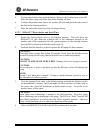
M
Millenium™ RO System by GE Osmonics
14693e - 31 Mar 03 4- 10 Routine Maintenance
4.3 Millenium™ Cleaning Indications
Foulants such as minerals, silt and organic substances may collect on the RO membrane
surface and cause the RO membrane to foul and diminish in its function. Many of these
foulants are prevented by proper selection of pretreatment equipment, while others are
treatable only with more sophisticated designs. Regardless of the foulant, it is essential
to clean the membrane promptly once cleaning is indicated. The longer a foulant is
allowed to remain in contact with the RO membrane, the more difficult it will be to
remove. In severe cases, repeated cleanings may be required.
NOTE:
Some foulants CANNOT be removed with cleaning and membrane performance
may not be fully restored. Observe the appearance of the cleaning solution before
discarding it. If the solution is heavily soiled, repeat the cleaning procedure with
fresh solution of the same type (high pH or low pH).
Routine cleaning of the RO membranes in conjunction with regular disinfection will keep
bacteria counts at a minimum and the RO membrane performance at its best. Cleaning
removes the silt, organic and mineral deposits that collect on the RO membrane surface
which, if left untreated, encourage bacterial growth and will eventually impair the RO
membranes' ability to perform. Disinfection kills most of the bacteria that may be present
in the system, but it does not remove the deposits on the membrane.
There are a variety of indications for cleaning membranes. The most common is a
reduced product flow rate. Remember that a reduction in inlet water temperature can also
result in a reduced flow rate. Refer to Technote 113 "Temperature Correction Factors" to
determine the reduction in flow that can be attributed to reduced water temperature.
Clean the membranes whenever the temperature compensated flow rate drops by 10%. A
loss in the membrane performance (percent rejection) or increase in TDS of the product
water may also be an indication to clean the membranes. A good preventative
maintenance practice is to clean the membranes on a quarterly basis, and more often if
needed.
CAUTION:
Membranes that have not been cleaned for a long time may actually incur damage
during cleaning as perforations are exposed that were masked by accumulations of
foulant. Regular maintenance cleaning is the best assurance of long membrane
service.


















